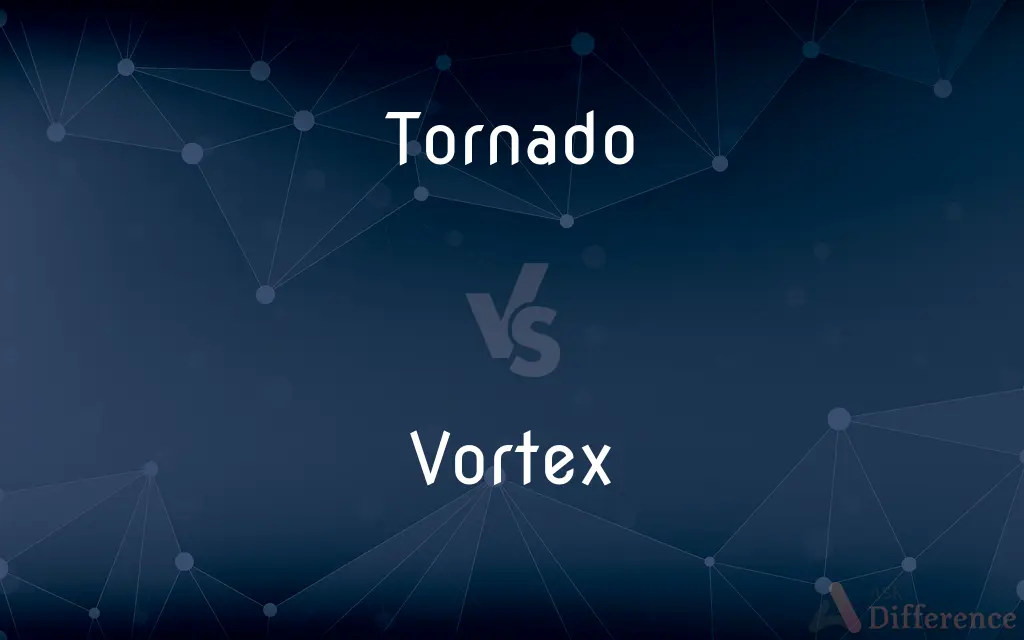Tornado vs. Vortex — What's the Difference?
Edited by Tayyaba Rehman — By Fiza Rafique — Updated on April 4, 2024
A tornado is a violently rotating column of air in contact with both the ground and a cumulonimbus cloud, while a vortex refers to any spinning flow of fluid or gas, including tornadoes but not limited to them.

Difference Between Tornado and Vortex
Table of Contents
ADVERTISEMENT
Key Differences
A tornado represents a specific type of vortex, characterized by its intense wind speeds, its connection between the ground and a cumulonimbus cloud, and its potential for destruction, typically forming in severe thunderstorms. On the other hand, a vortex can describe any rotating flow, including whirlpools, dust devils, and the atmospheric circulations within hurricanes, showcasing a broader category of phenomena.
While tornadoes are noted for their destructive potential, particularly in terms of their ability to cause significant damage to structures, uproot trees, and lift objects into the air, vortices, in general, can range from harmless to highly destructive. The scale and impact of a vortex depend on its context, such as a small bathtub whirlpool versus the powerful rotation of a hurricane.
The formation of a tornado is driven by specific atmospheric conditions, including temperature gradients, humidity, and wind shear, within severe thunderstorms. Conversely, vortices can form in a variety of settings, from large-scale atmospheric circulations to the simple act of stirring a cup of tea, governed by the principles of fluid dynamics and differences in pressure.
Tornadoes are classified according to the Enhanced Fujita scale, which measures the intensity based on damage caused. In contrast, vortices may not have a specific scale for measurement unless they fall into categories like tornadoes or hurricanes, which have their own scales (the Saffir-Simpson scale for hurricanes).
The study of tornadoes is a specialized field within meteorology, focusing on prediction, tracking, and understanding their impact on communities. Vortex dynamics, however, spans a broader range of disciplines, including physics and engineering, highlighting the wide applications and implications of rotational flows in various fields.
ADVERTISEMENT
Comparison Chart
Definition
A violently rotating column of air connected to both the ground and a cumulonimbus cloud.
Any rotating flow of fluid or gas.
Context
Severe thunderstorms.
Various, including atmospheric phenomena, fluid dynamics, and mechanical systems.
Scale of Impact
Typically localized but can be extensive and highly destructive.
Ranges from minor and harmless to globally significant.
Formation
Specific atmospheric conditions, including wind shear and temperature gradients.
Broad range of conditions, governed by fluid dynamics and pressure differences.
Measurement
Enhanced Fujita scale based on damage.
Varies; specific scales for certain types like tornadoes and hurricanes.
Study Field
Meteorology, specifically tornado prediction and impact assessment.
Physics, engineering, and environmental sciences, among others.
Compare with Definitions
Tornado
A violent, rotating column of air.
The tornado destroyed homes and uprooted trees in its path.
Vortex
Includes tornadoes and whirlpools.
The divers observed a powerful vortex offshore.
Tornado
Connected to severe weather.
Tornado warnings were issued ahead of the approaching storm.
Vortex
Governed by fluid dynamics.
Engineers analyzed the vortex shedding on bridge designs.
Tornado
Causes significant destruction.
The town is rebuilding after last year's devastating tornado.
Vortex
A spinning flow of fluid or gas.
A vortex formed as water drained from the sink.
Tornado
Focus of meteorological research.
Researchers are developing better prediction models for tornadoes.
Vortex
Can be observed in various scales.
Scientists study the Great Red Spot, a giant vortex on Jupiter.
Tornado
Measured by the Enhanced Fujita scale.
The tornado was classified as an EF3, with winds up to 165 mph.
Vortex
Broadly studied across disciplines.
Vortex dynamics is crucial in understanding atmospheric patterns.
Tornado
A tornado is a violently rotating column of air that is in contact with both the surface of the Earth and a cumulonimbus cloud or, in rare cases, the base of a cumulus cloud. The windstorm is often referred to as a twister, whirlwind or cyclone, although the word cyclone is used in meteorology to name a weather system with a low-pressure area in the center around which, from an observer looking down toward the surface of the earth, winds blow counterclockwise in the Northern Hemisphere and clockwise in the Southern.
Vortex
In fluid dynamics, a vortex (plural vortices/vortexes) is a region in a fluid in which the flow revolves around an axis line, which may be straight or curved. Vortices form in stirred fluids, and may be observed in smoke rings, whirlpools in the wake of a boat, and the winds surrounding a tropical cyclone, tornado or dust devil.
Tornado
A violently rotating column of air extending from a cumulonimbus cloud to the ground, ranging in width from a few meters to more than a kilometer, with destructive winds up to 510 kilometers (316 miles) per hour or higher. Tornadoes are typically associated with a funnel cloud pendant from a storm's wall cloud, often extending to the bottom of the tornado.
Vortex
A whirling mass of fluid or air, especially a whirlpool or whirlwind
A swirling vortex of emotions
We were caught in a vortex of water
Tornado
A violent thunderstorm in western Africa or nearby Atlantic waters.
Vortex
A whirling mass of water or air that sucks everything near it toward its center.
Tornado
A whirlwind or hurricane.
Vortex
A place or situation regarded as drawing into its center all that surrounds it, and hence being inescapable or destructive
A vortex of political infighting.
A vortex of despair.
Tornado
(meteorology) A violent windstorm characterized by a mobile, twisting, funnel-shaped cloud.
A tornado is a rotating column of air.
Vortex
A whirlwind, whirlpool, or similarly moving matter in the form of a spiral or column.
Tornado
A violent whirling wind; specifically (Meteorol.), a tempest distinguished by a rapid whirling and slow progressive motion, usually accompaned with severe thunder, lightning, and torrents of rain, and commonly of short duration and small breadth; a small cyclone.
Vortex
(figuratively) Anything that involves constant violent or chaotic activity around some centre.
Tornado
A localized and violently destructive windstorm occurring over land characterized by a funnel-shaped cloud extending toward the ground
Vortex
(figuratively) Anything that inevitably draws surrounding things into its current.
Tornado
A purified and potent form of cocaine that is smoked rather than snorted
Vortex
(historical) A supposed collection of particles of very subtle matter, endowed with a rapid rotary motion around an axis which was also the axis of a sun or planet; part of a Cartesian theory accounting for the formation of the universe, and the movements of the bodies composing it.
Vortex
(zoology) Any of numerous species of small Turbellaria belonging to Vortex and allied genera.
Vortex
(chemistry) To mix using a vortex mixer
Vortex
A mass of fluid, especially of a liquid, having a whirling or circular motion tending to form a cavity or vacuum in the center of the circle, and to draw in towards the center bodies subject to its action; the form assumed by a fluid in such motion; a whirlpool; an eddy.
Vortex
A supposed collection of particles of very subtile matter, endowed with a rapid rotary motion around an axis which was also the axis of a sun or a planet. Descartes attempted to account for the formation of the universe, and the movements of the bodies composing it, by a theory of vortices.
Vortex
Any one of numerous species of small Turbellaria belonging to Vortex and allied genera. See Illustration in Appendix.
Vortex
The shape of something rotating rapidly
Vortex
A powerful circular current of water (usually the resulting of conflicting tides)
Common Curiosities
What makes a tornado different from other vortices?
A tornado is specifically a weather phenomenon with a distinct connection to both the ground and a cloud, known for its destructive potential.
Can all vortices cause damage like tornadoes?
Not all vortices are destructive; the impact varies widely depending on the type and scale of the vortex.
Can vortices occur in other planets' atmospheres?
Yes, vortices are a universal phenomenon and can be found in the atmospheres of other planets, such as the Great Red Spot on Jupiter.
How do meteorologists predict tornadoes?
Meteorologists use radar, satellite data, and understanding of atmospheric conditions to predict tornado formation and issue warnings.
What role do vortices play in engineering?
In engineering, understanding vortices can help in designing structures and systems to withstand or utilize rotational flows effectively.
How are vortices formed in nature?
Vortices in nature can form due to differences in fluid or air pressure and temperature, among other factors.
Why do tornadoes have a specific scale for measurement?
The Enhanced Fujita scale helps categorize tornadoes based on their potential for destruction to aid in response and research.
Are there efforts to control or mitigate tornadoes?
While controlling tornadoes is not currently feasible, efforts focus on improving prediction, warning systems, and building practices to reduce impact.
Is vortex flow always harmful?
Vortex flow is not inherently harmful and can be observed in everyday situations, like stirring a liquid, with no adverse effects.
How does vortex formation contribute to weather patterns?
Vortices play a significant role in shaping weather patterns, from small-scale effects like tornadoes to large-scale systems like hurricanes.
Share Your Discovery

Previous Comparison
Administer vs. Underdose
Next Comparison
Smart vs. StingAuthor Spotlight
Written by
Fiza RafiqueFiza Rafique is a skilled content writer at AskDifference.com, where she meticulously refines and enhances written pieces. Drawing from her vast editorial expertise, Fiza ensures clarity, accuracy, and precision in every article. Passionate about language, she continually seeks to elevate the quality of content for readers worldwide.
Edited by
Tayyaba RehmanTayyaba Rehman is a distinguished writer, currently serving as a primary contributor to askdifference.com. As a researcher in semantics and etymology, Tayyaba's passion for the complexity of languages and their distinctions has found a perfect home on the platform. Tayyaba delves into the intricacies of language, distinguishing between commonly confused words and phrases, thereby providing clarity for readers worldwide.














































